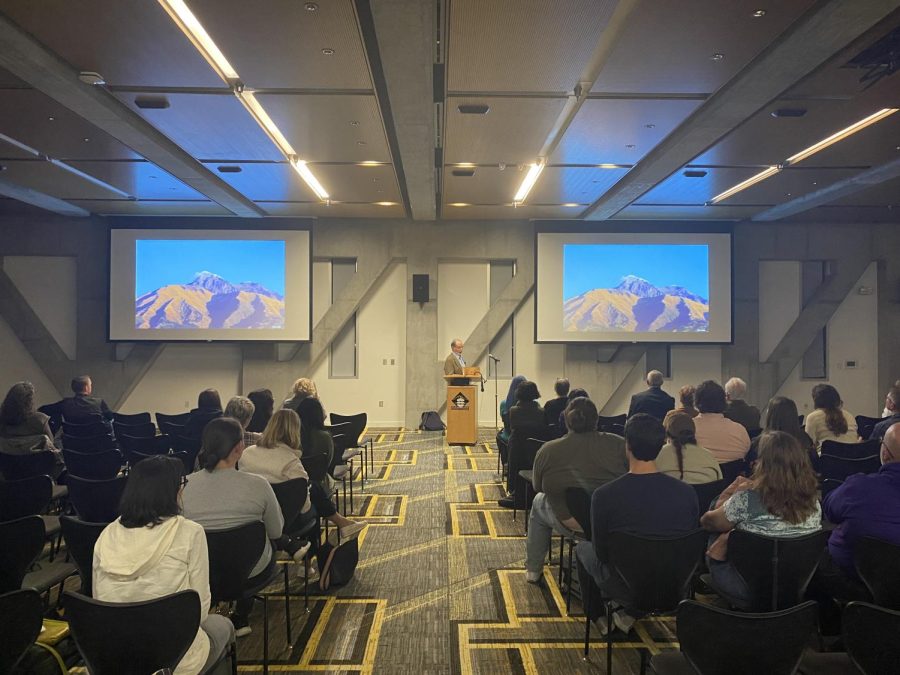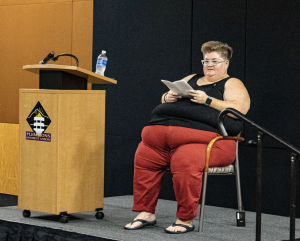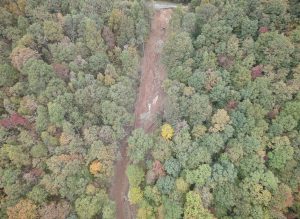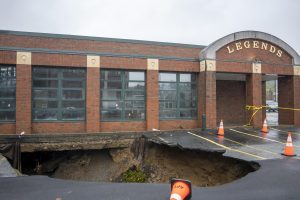Guest lecture explores ‘sacred’ nature of mountains
Edwin Bernbaum discusses modern photos of Cotacachi, now largely devoid of glacial ice due to the effects of climate change.
October 4, 2022
The mountains around App State were shown in a new light Thursday as experienced mountaineer and scholar Edwin Bernbaum delivered a guest lecture, “Sacred Mountains of the World,” to an audience of students, faculty and community members alike.
The event, which was hosted by the College of Arts and Sciences, took place in Plemmons Student Union’s Parkway Ballroom from 6-9 p.m. It explored the nature of mountains and the roles they play in culture, history, mythology and more.
Following the event, attendees had the opportunity to purchase a signed copy of Bernbaum’s book, also titled “Sacred Mountains of the World.”
The event was part of a larger Mountain Studies lecture series intended to take place every other year. Lauren Andersen, director of marketing, communication and engagement for the College of Arts and Sciences, said the previous Mountain Studies lecture, which was set to be the first, was originally scheduled for March 2020 and had to be moved to a virtual format due to the COVID-19 pandemic.
“This year is really our first in-person Mountain Studies lecture, so we’re really excited to get people actually sitting down, listening to our lecturer, meeting them in person,” Andersen said. “It’s really exciting.”
Before he took to the podium, Bernbaum was briefly introduced by Mike Madritch, interim dean of the College of Arts and Sciences. Following this introduction, he discussed the topic of his lecture and what he hoped those in attendance would learn from it.
“What I’d like you to come away with from this is just the incredible range and diversity of ways in which mountains are sacred around the world and their importance in all sorts of different fields and for people in general: indigenous people, followers of religions and even the secular public,” Bernbaum said.
After discussing his childhood in Quito, Ecuador and Washington, D.C., Bernbaum transitioned to what inspired the creation of his book.
Bernbaum recounted one of his earliest ventures to Tibet, during which he spent about 10 days trekking to the city of Kathmandu with the abbot of Tengboche Monastery. During this time, he had the idea of microfilming the monastery’s texts to preserve them in the event that they were destroyed, which ultimately inspired the creation of his first book: “The Way to Shambhala: A Search for the Mythical Kingdom Beyond the Himalayas.”
Having delivered an all-day seminar on this topic for the University of California, Berkeley, Extension, he was asked to give another, for which he proposed the idea of myths and legends of the Himalayas. After being asked to “make it broader,” Bernbaum settled on the topic of “sacred mountains of the world” and subsequently delivered seminars at Berkeley and the Smithsonian Institution.
“In the course of doing this, as I say, I became interested in what mountains mean to people in cultures around the world,” Bernbaum said. “Obviously, they’re intensely meaningful to me and I’m sure they’re meaningful to you as well because you’re living right here in the mountains.”
Bernbaum then transitioned to the primary subject of his lecture, which was the 10 themes he has identified through which people view mountains as sacred. These include height, center, power, deity or the abode of a deity, temple or place of worship, garden or earthly paradise, ancestors and the dead, sources of identity, source of blessings or resources and the overall theme of transformation, revelation, inspiration and renewal.
“Both in a religious sense and even a secular sense, mountains evoke an experience of something of deeper significance in reality that gives meaning and vitality to people’s lives, so we’ll take that as a point of departure,” Bernbaum said.
Bernbaum then recounted his experience with an avalanche on the slopes of Nepal’s Annapurna, which he said was a “powerful” moment in his life. The collapse of a hanging glacier triggered an avalanche which swept him an estimated 1,000 feet down the mountain, where Bernbaum and a companion were able to dig themselves out of the snow and narrowly avoid a second one.
“There were a lot of things that I learned from it afterwards, but one of the things that happened was in the middle of the night afterwards, I expected to have terrible nightmares and I had the best night’s sleep I’d had in a long time,” Bernbaum said.
Bernbaum said that “for the first time on the entire expedition,” he “felt like climbing a mountain just for the sheer joy of climbing it,” rather than to accomplish something.
“It took me many years to really understand that when you do things just for the sheer joy of doing them, that’s when you do the best and have your best effects on other people,” Bernbaum said.
Bernbaum additionally discussed his work with several organizations and projects. Some of them include the Badrinath Reforestation Project, the Sacred Mountains Program, the International Union for Conservation of Nature and the installation of signs highlighting Cherokee history and culture along the Great Smoky Mountains National Park’s Oconaluftee River Trail.
As the last topic of discussion in his seminar, Bernbaum also highlighted climate change and its implications for the mountains.
“Almost all the glaciers are gone on the equator,” Bernbaum said. “So the thing about mountains is along with the Arctic and the Antarctic, they’re the place where you first see the impacts of global warming and climate change, very dramatic, especially on the equator.”
Bernbaum discussed the implications climate change and global warming also have for people and cultures that hold mountains in high regard. He additionally explained the manners in which people are attempting to slow this process, such as attempting to create new glaciers and covering existing glaciers with tarps.
Before opening the floor to questions from the audience, Bernbaum concluded his lecture with an excerpt from the last paragraph of his book.
“Mountains help us to regain that sense of freshness and wonder possessed by a child, eyes bright and clear, hearts open and free,” Bernbaum said. “We stand once again at the beginning and source of all that is and all that may be.”
Bernbaum said he hopes those who attended his lecture will have come out of it with a deeper understanding of other cultures and the roles that mountains play.
“One of the things you can come away with is just, you know, the way mountains can enrich your experience, and also they provide a great bridge across cultural understanding,” Bernbaum said.
Senior biological anthropology student Anna Lee said that it’s “really special” to learn about “sacred mountains” elsewhere in the world, because what other people and cultures consider valuable has both “really great continuity” and “a uniqueness” that is a particular focus of App State.
“Topics like this are really glazed over when you’re looking at general curriculum,” Lee said.













Lauren Andersen • Oct 5, 2022 at 8:46 am
Excellent job on this article, William!